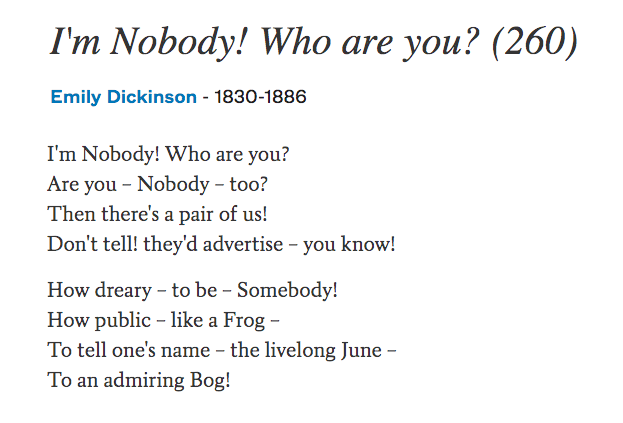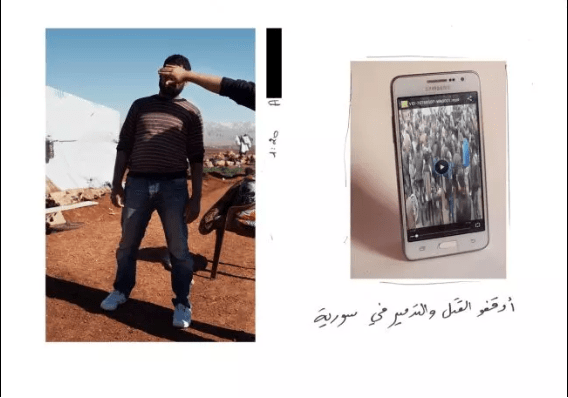Literary Text:

Context:
Emily Elizabeth Dickinson was an American poet. She was born on December 10, 1830 in Amherst, Massachusetts. She was born into a prominent family with strong ties to its community. As a child she studied at Amherst Academy and briefly Mount Holyoke Female Seminary, before returning to her family’s home. Dickinson lived much of her life in isolation, she never married, and most friendships between her and others were through letters rather than face to face. She was thought to be very eccentric, and developed a strong liking for white clothing and later in life was known for her reluctance to leave her bedroom.
Text:
Point: The poet describes herself as a nobody, and then reaches out to reader’s who feeling the same as her by asking if they are also nobody.
Evidence: ‘I’m nobody! Who are you? Are you – nobody – too?’ Lines 1-2
Analysis: The first stanza reveals what Dickinson thinks of herself – that she is a nobody. Although being a nobody to most would be a negative thing, her use of an exclamation mark reveals she is actually excited to be a nobody. However that can come into question when she is asking her readers if they are a nobody too. She longs to reach out to others who feel as she does. This first line is crucial in trying to understand the fighting sides of Dickinson’s identity – that although she wants to be isolated and viewed as nothing to the public, her isolation also makes her want to connect to those in the same position.
Point: In lines 3-4 Dickinson creates an us and them mindset with the readers, connecting herself to us as nobodies and referring to the public as they. Which also shows her feeling of isolation and difference from others and her want for a connection to someone feeling the same
Evidence: ‘Then there’s a pair of us! Don’t tell! They’d advertise – you know!’ Lines 3-4
Analysis: I think these lines further show Dickinson’s identity. She wants someone to read this and feel as she does by writing ‘Then there’s a pair of us!’ Her use of a exclamation mark again shows her excitement in finding someone who also identifies as a ‘nobody.’ When she writes ‘Don’t tell! They’d advertise – you know!’ shows that she was clearly afraid of being known to the world. Dickinson seemed to of enjoyed having no fame and no recognition, and feared that if someone found out that she was content being “nobody” they would advertise her and make into into “somebody” and she dreaded that.
Point: Line 5 shows the side of Dickinson that enjoys being alone and unknown the the public by insulting those who are known
Evidence: ‘How dreary – to be – somebody!’ Line 5
Analysis: The full poem shows Dickinson’s like to be a kind of mystery to the world as she positively describes herself as a nobody. She then insults people who are a ‘somebody.’ She explains exactly why she does not wish to be anybody, and that it would be “dreary-to be- Somebody”. She prefers to be left alone.
Point: Finally Dickinson describes the public as ‘a frog’ and telling her name
Evidence: ‘How public – like a frog – to tell one’s name – […] – To an admiring bog!’ Line 6-8
Analysis: Dickinson strange comparison of a public person to a frog is possibly because frogs live out in the open, resting on lily pads in ponds, or because frogs are very loud and inflict attention on themselves. She believes that to live as a nobody is better than to live out in the open. So she compares frogs to people who live in the public eye – ‘a somebody.’ The last two lines of this poem reveal her distaste at living her life to tell of her own name ‘to an admiring bog’. A ‘bog’ is a place in which a frog lives. Which gives us insight into her comparison of a ‘somebody’ to a frog. Frogs croak constantly, telling its existence only to the bog. When frogs croak nothing happens and no one hears or cares, so this shows why Dickinson would prefer to be unknown. Because if she were to to tell of her existence to the public, just as a frog in a bog, no one would care or listen.
Overall Conclusion:
This poem shows Dickinson’s identity in a complicated way. The whole poem is about self-identity, however instead of Dickinson identifying who she is as a person, she describes herself as not even a person, and as a ‘nobody.’ She lived most of her life in isolation, and her writing only became really known after her death. The poem gives the idea she is scared of being somebody known and that if she became known, and went around advertising and telling her name to the public, no one would care or listen. I think the fear Dickinson had of becoming a known person reflected how she lived her life and consequently shaped her identity. The poem also reveals a struggle within herself as a result of her isolation, she seemed to be lonely, reaching out to a reader who may feel like a nobody too.
Non-Literary Text:

Context:
The photographer Alex John Beck, went on a project to document the Syrian refugee crisis and travelled to camps in Lebanon and Jordan. Instead of taking his own photos to communicate what was happening, he decided that using the refugees own phones would more powerfully communicate this message. The photo depicts a Syrian refugee standing in the sun with someone covering his face with their hands. Next to the image of the man is another image of his phone, which had captured videos of the crisis.
Text:
Point: The photos almost dehumanise the single refugees as individual people with individual stories, by covering the face of each refugee
Evidence: In almost all the photos in Beck’s exhibition, you cannot see the face of the refugee, as someone is covering it.
Analysis: By not being able to see the face of the individual in the photograph, it almost dehumanises him by making it impersonal. To the viewer of the photograph, we see just another person in Syria. Giving off the impression he is just one of the many others in that situation and creates a stereotype of the people in the Syrian crisis. I don’t think this was chosen to purposely not represent this man, however I think showing this mans face wasn’t regarded as important to Beck, as the conventions of his exhibition and this photo were to show the situation not the man. So unfortunately as a result this photograph disregards the refugees as individuals who all own their own narratives and identity.
Point: The videos captured on the refugees phones depicts moments from the crisis in Syria, limiting the man’s identity to just another person displaced as a result of the crisis.
Evidence: This specific photo in Beck’s Exhibition shows one image captured from the mans cellphone. The photo seems to be showing a large gathering of Syrian people who are possibly protesting.
Analysis: The image on the mans cellphone, I think is very limiting. Showing just one photograph cannot fully represent this mans identity. Even more so, having the photograph depict some event in the Syrian crisis makes it represent this mans identity even less, because the photograph shows something so impersonal to just this individual as so many Syrians are seeing and experiencing moments like this too. The conventions of the image on the mans cellphone, undoubtedly was chosen to further show the crisis in Syria. Beck did not choose this photo to show this mans identity, but to continue to communicate his message of whats happening to his audience. Without disregarding the fact that the Syrian civil war undoubtedly has had an impact on every individual there, and in some way has shaped their identities. I don’t think this means that this mans identity should be limited to just the issue in Syria.
Point: The caption of this photo inflicts sympathy on its viewers, and does help to show this mans identity, however only through the lens of the hardships he has experienced.
Evidence: The handwritten caption in the photograph reads: “I heard my neighbourhood was destroyed. Nothing left.”
Analysis: I think that the caption of this photograph can help the viewers understand more about this mans experience, however once again is only focusing on his identity through the lens of the Syrian crisis. I think that this caption, much like the other aspects of the photograph, is more for the artists representation of people suffering in Syria, rather than the actual identity of each and every Syrian refugee featured.
Overall Conclusion:
I think that this photograph, and Beck’s entire exhibition more so communicated what was happening in Syria, to people on the outside, rather than telling the narratives of each and every individual. The photograph focuses on the impact of the crisis on each individual, and although does that splendidly, I don’t think that this can be said to be a full representation of identity. People are not only shaped by one thing, there identity is formed by more aspects such as their beliefs, morals, the people they meet as well as other life experiences. So although the exhibition inflicts sympathy on the viewers for Syrian people, it represents them as only people in a horrible situation. Which makes the viewers see all these different people as one group. Falling short in telling the full narrative and showcasing the true identity of the individuals.
Intertextuality:
The most distinct difference between Emily Dickinson’s poem ‘I’m Nobody! Who are you?’ and Alex John Beck’s photograph, is the chosen aspect of what shaped their identities. For Dickinson, a fear she had of being public caused her to live her life in isolation. For the refugee featured in Beck’s photographs, the incredibly difficult situation he was living through. Both help us more understand the identities of these individuals, however more so the poem, this is because I think when looking at someones identity, the best person to represent their identity is the person whose identity it is. As Dickinson’s identity can be shown through her own writing, we get a better insight into her thoughts, beliefs and even fears – aspects that are vital in shaping identity. Also because Dickinson’s poems were never meant to be public, she was more open in her writing as her writing’s audience was only her. Beck’s photograph is an attempted representation of this refugees identity. But is nothing more than a covered face, one photograph and a sentence of writing, all through the lens of one experience. This, as a result, gives more insight into how the situation in Syria is impacting Syrian’s, more than it does this mans identity. However, Beck’s photographs intent was not to represent this specific mans identity, but to show people on the outside how the Syrian refugees are impacted by the issue. So therefore, the audience isn’t getting a grasp of the refugees identity because that wasn’t the photographers intent.




